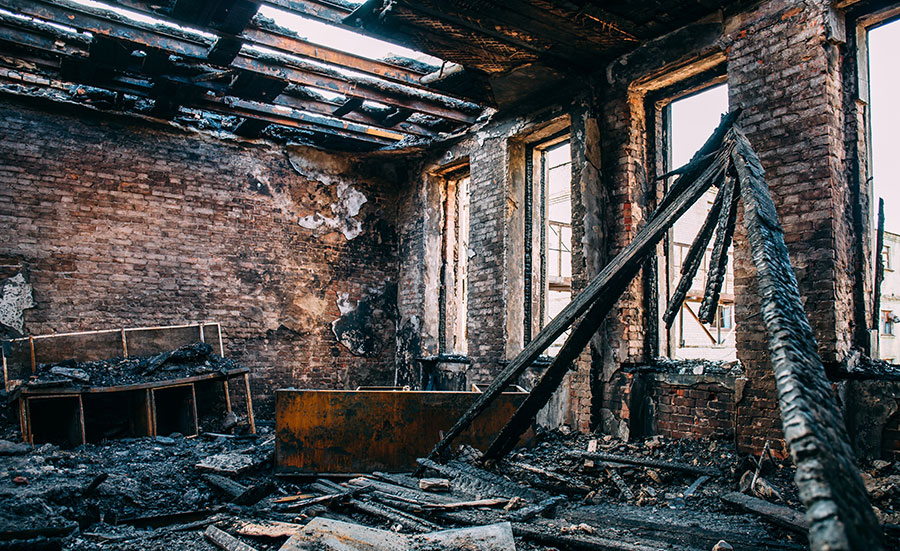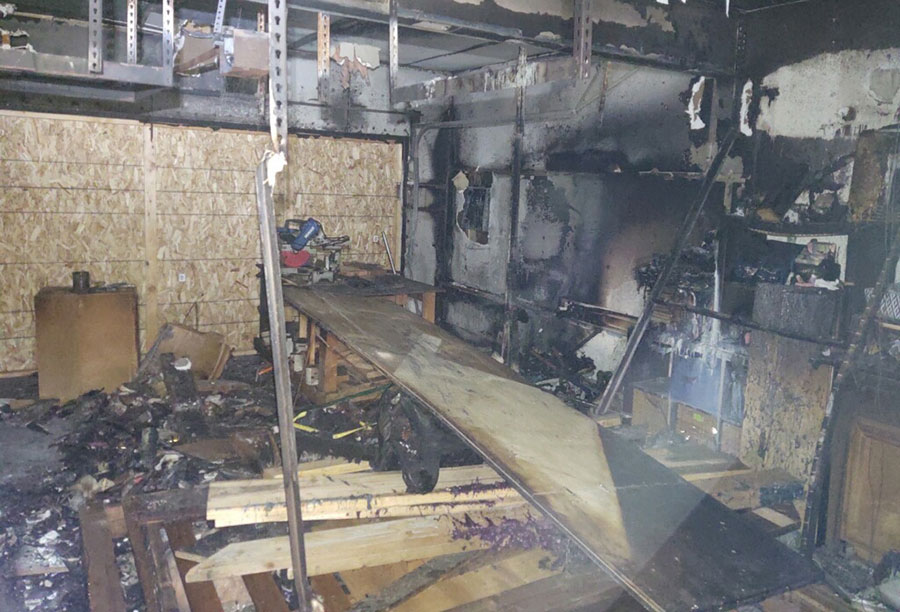Fire damage extends beyond visible destruction, leaving behind hazardous byproducts that threaten both health and property. Smoke, soot, char, and volatile organic compounds (VOCs) can linger in building materials, fabrics, and indoor air, posing long-term safety concerns.
Wildfires, structure fires, and even small household fires produce toxic chemicals, fine particulates, and acidic residues that can degrade surfaces, electronics, and textiles, while impacting indoor air quality.
Rarefied Air Environmental (RAE) provides professional fire and smoke-damage assessments, using advanced inspections, testing, and analysis to identify hazards, guide effective remediation, and verify that properties are safe for occupancy. Pre- and post-remediation evaluations also support insurance claims and ensure compliance with industry standards.
Soot & Smoke Testing
What is Soot?
Smoke is a complex mixture of toxic gases and particles, which are generated from the various materials that burn during a fire. A typical structure fire may generate literally tens of thousands of toxic chemicals and gasses as a variety of materials and products are burned.
Soot is the carbonaceous deposits remaining after incomplete combustion. Soot is typically black or gray, whereas ash is typically white or light gray. Soot can contain traces of the fuel that caused it, allowing the identification of the source. Soot and the combustion byproducts associated with it can be harmful.

Wildfire Soot Claims
A growing concern in the insurance sector is soot and smoke damage claims due to wildfires. Some of these fires can affect properties hundreds of miles downwind, causing the potential number of claims to be astronomical. Besides the known risks for respiratory and other health problems, smoke, soot, and char can cause physical damage ranging from settled ash to property damage.
Depending on the type and amount of soot, the remediation can range from simple cleaning to professional cleaning and even replacement of soft goods (fabrics and carpeting) and/or electronic appliances.
San Diego wildfires in Rancho Bernardo, Bonsall, Vista, Oceanside, Poway, Carlsbad, San Marcos and as far south as Chula Vista have caused concerns on behalf of The San Diegan Community. Please do not allow fly-by-night contractors cash in on your misfortune. Trust the professionals. Get pre-and-post-remediation site assessments to develop a scope of work and ensure the effectiveness of restoration!
Why Test for Soot?
Following a structure fire, there are several contaminants that may be present on the remaining materials and in the breathable air that can cause cancer or lingering odors in your home. Depending on the types of materials that have been burned, several different types of combustion by-products may be present in the soot in your livable space.
The presence of soot on the remaining materials of your home may cause discoloration of materials/paints due to the acidic properties as well as causing heavy elements of soot to settle in porous construction products resulting in smoke-like odors that can last up to years!
Rarefied Air Environmental will follow the industry standards in developing a scope of work that will assist in a remediation project. We will provide a scope of work based upon the findings of surface samples and visual assessments. The scope of work can be given independently to a contractor so as to also ensure that not too much or too little of restoration is performed.
Several other forms of testing are recommended following fire restoration including Volatile Organic Compounds (VOC’s), heavy metals, mercury, Polychlorinated biphenyls (PCB’s), etc. However, soot surface sampling is now currently regarded as the standard following fire restoration activities. Just as in asbestos, lead or mold, soot testing is a tool used to assess the effectiveness of remediation recently performed. Any reputable contractor would recommend that post-remediation-sampling occur to ensure the home is returned to pre-loss conditions.
Comprehensive Smoke Testing & VOC Analysis for Fire-Damaged Properties
When fire affects a property, it creates a complex web of chemical compounds from the combustion of modern building materials, furnishings, and household items. Advanced testing services identify and measure specific VOCs, smoke-related particulates, and surface contamination levels. Through detailed documentation and professional analysis, clear evidence of contamination is provided to develop targeted remediation strategies to ensure your space is safe for occupancy.
Certified professionals understand that every fire incident is unique and requires a customized approach to assessment and remediation, whether dealing with a recent fire or investigating lingering effects from past damage. Testing supports insurance requirements, litigation needs, and protects the health of building occupants.

Advanced Testing Protocols
Testing protocols incorporate multiple sampling methods to build a complete picture of contamination:
- Surface wipe sampling
- Soot/char/ash tape lift analysis
- Air quality monitoring
- Bulk material analysis
Learn more about our testing methods for fire and smoke damage.
These methods follow ASTM D6602-13 standards, ensuring precision in detecting contaminants like ash-like soot, char-like soot, and aciniform-like soot, which are critical indicators of fire and smoke damage. Laboratory analysis identifies not just the presence of contaminants but also their specific compositions and concentrations.
For example, ash-like soot, formed from wood combustion, and char-like soot, indicative of incomplete combustion, often exceed acceptable thresholds in post-fire environments. Our analysis pinpoints these concentrations to determine whether remediation actions like HEPA vacuuming, wet wiping, or material replacement are necessary.
Key Features of Our Services
VOC Testing and Analysis
Volatile organic compounds (VOCs) are often released during fires due to the combustion of building materials, household products, and furnishings. Harmful compounds like formaldehyde, benzene, and polycyclic aromatic hydrocarbons (PAHs) linger in fire-damaged environments. Using advanced VOC analysis, RAE identifies these toxins to create tailored remediation plans and restore indoor air quality. For more on this topic, read about VOC testing in fire-damaged environments.
Smoke Particulate Testing
Fine particulate matterposes significant health risks by penetrating deep into the lungs and bloodstream. Fire events generate harmful particulates that settle onto surfaces or remain airborne. Our specialized testing measures their concentration and composition, enabling remediation using HEPA filtration systems and advanced cleaning methods. Learn about the health impacts of smoke particulates.
Textile Assessment
Smoke-damaged fabrics and textiles can harbor VOCs, particulates, and soot. Evaluation determines whether materials like upholstery, clothing, and bedding can be salvaged or require replacement, recommending effective decontamination techniques.
Accurate Assessment & Scope of Work
Rarefied Air Environmental (RAE) provides professional fire and smoke-damage assessments, using advanced inspections, testing, and analysis to identify hazards and guide effective remediation. Certified fire inspectors and environmental testing specialists develop detailed scopes of work based on surface samples, air monitoring, and laboratory analyses.
This consolidated approach ensures:
- Remediation is neither underperformed nor excessive.
- Post-remediation success is verified.
- Properties are restored to pre-loss conditions.
- Insurance, health, and safety standards are supported.
Read more about smoke testing and VOC analysis:
